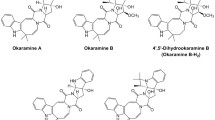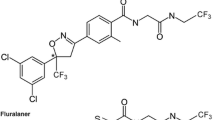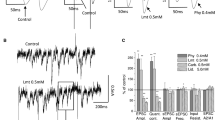Abstract
4′-Ethynyl-4-n-propylbicycloorthobenzoate (EBOB) has been employed extensively as a radioligand in binding assays to evaluate the pharmacology of γ-aminobutyric acid (GABA)-gated Cl− channels (GABARs) of insects and mammals, and γ-hexachlorocyclohexane (γ-HCH) was used as an insecticide targeting insect GABARs. Since recent studies have shown that not only GABARs but also glutamate-gated chloride channels (GluCls) are blocked by picrotoxinin, dieldrin and fipronil, the actions of EBOB and γ-HCH on native GABARs and GluCls of terminal abdominal ganglion neurons in American cockroach (Periplaneta americana) were tested using patch-clamp electrophysiology. A marked run-down of the GABA- and glutamate-induced responses of the cockroach neurons occurred, when a standard pipette solution was employed, but addition of pyruvate to the solution permitted stable recordings of these responses. With this solution, EBOB and γ-HCH were found to block not only the GABA- but also glutamate-gated responses, with the actions augmented by repeated co-application with the agonists. It was also found that prolonged pre-application of EBOB and γ-HCH prior to co-application with GABA and glutamate resulted in enhanced blocking actions, indicating resting-state actions of the blockers. The blocking actions of EBOB and γ-HCH on the GABA- and glutamate-induced responses were compared by determining IC50 values under steady state condition. The IC50 values for the actions of EBOB on GABAR and GluCls differed less than those of γ-HCH.







Similar content being viewed by others
References
Alix P, Grolleau F, Hue B (2002) Ca2+/calmodulin-dependent protein kinase regulates GABA-activated Cl− current in cockroach dorsal unpaired median neurons. J Neurophysiol 87:2972–2982
Bloomquist JR (2001) GABA and glutamate receptors as biochemical sites for insecticide action and resistance. In: Ishaaya I (ed) Biochemical sites important in insecticide action and resistance. Springer, Berlin Heidelberg New York, pp 17–41
Bloomquist JR (2003) Chloride channels as tools for developing selective insecticides. Arch Insect Biochem Physiol 54:145–156
Cleland TA (1996) Inhibitory glutamate receptor channels. Mol Neurobiol 13:97–136
Cole LM, Casida JE (1992) GABA-gated chloride channel: binding site for 4′-ethynyl-4-n[2,3–3H2]-propylbicycloorthobenzoate ([3H]EBOB) in vertebrate brain and insect head. Pestic Biochem Physiol 44:1–8
Cole LM, Nicholson RA, Casida JE (1993) Action of phenylpyrazole insecticides at the GABA-gated chloride channel. Pestic Biochem Physiol 46:47–54
Connolly CN, Wafford KA (2004) The Cys-loop superfamily of ligand-gated ion channels: the impact of receptor structure on function. Biochem Soc Trans 32:529–539
Deng Y, Casida JE (1992) House fly head GABA-gated chloride channel: Toxicologically relevant binding site for Avermectins coupled to site for ethynylbicycloorthobenzoate. Pestic Biochem Physiol 43:116–122
Deng Y, Palmer CJ, Casida JE (1993) House-fly head GABA-gated chloride channel: Four putative insecticide binding sites differentiated by [3H]EBOB and [35S]TBPS. Pestic Biochem Physiol 47:98–112
Hamill OP, Marty A, Neher E, Sakmann B, Sigworth FJ (1981) Improved patch-clamp techniques for high-resolution current recording from cells and cell-free membrane patches. Pflugers Arch 391:85–100
Horoszok L, Raymond V, Sattelle DB, Wolstenholme AJ (2001) GLC-3: a novel fipronil and BIDN-sensitive, but picrotoxinin-insensitive, L-glutamate-gated chloride channel subunit from Caenorhabditis elegans. Br J Pharmacol 132:1247–1254
Ikeda T, Zhao X, Kono Y, Yeh JZ, Narahashi T (2003) Fipronil modulation of glutamate-induced chloride currents in cockroach thoracic ganglion neurons. Neurotoxicology 24:807–815
Ludmerer SW, Warren VA, Williams BS, Zheng Y, Hunt DC, Ayer MB, Wallace MA, Chaudhary AG, Egan MA, Meinke PT, Dean DC, Garcia ML, Cully DF, Smith MM (2002) Ivermectin and nodulisporic acid receptors in Drosophila melanogaster contain both γ-aminobutyric acid-gated Rdl and glutamate-gated GluCl α chloride channel subunits. Biochemistry 41:6548–6560
Matsumura F, Tanaka K, Ozoe Y (1987) GABA-related systems as targets for insecticides. In: Hollingworth RM, Green MB (eds) Sites of actions for neurotoxic pesticides. American Chemical Society, Washington DC, pp 44–70
Nagata K, Narahashi T (1995) Differential effects of hexachlorocyclohexane isomers on the GABA receptor-chloride channel complex in rat dorsal root ganglion neurons. Brain Res 704:85–91
Nagata K, Huang CS, Hamilton BJ, Carter DB, Narahashi T (1996) Differential effects of hexachlorocyclohexane isomers on the GABA receptor subunits expressed in human embryonic kidney cell line. Brain Res 738:131–137
Narahashi T (2002) Nerve membrane ion channels as the target site of insecticides. Mini Rev Med Chem 2:419–432
Ozoe Y, Akamatsu M (2001) Non-competitive GABA antagonists: probing the mechanisms of their selectivity for insect versus mammalian receptors. Pest Manag Sci 57:923–931
Rauh JJ, Benner E, Schnee ME, Cordova D, Holyoke CW, Howard MH, Bai D, Buckingham SD, Hutton ML, Hamon A, Roush RT, Sattelle DB (1997). Effects of [3H]-BIDN, a novel bicyclic dinitrile radioligand for GABA-gated chloride channels of insects and vertebrates. Br J Pharmacol 121:1496–1505
Raymond V, Sattelle DB (2002) Novel animal-health drug targets from ligand-gated chloride channels. Nat Rev Drug Discov 1:427–436
Raymond V, Sattelle DB, Lapied B (2000) Co-existence in DUM neurones of two GluCl channels that differ in their picrotoxin sensitivity. Neuroreport 11:2695–2701
Yagle MA, Martin MW, de Fiebre CM, de Fiebre NC, Drewe JA, Dillon GH (2003) [3H]ethynylbicycloorthobenzoate ([3H]EBOB) binding in recombinant GABAA receptors. Neurotoxicology 24:817–824
Zhao X, Salgado VL, Yeh JZ, Narahashi T (2003) Differential actions of fipronil and dieldrin insecticides on GABA-gated chloride channels in cockroach neurons. J Pharmacol Exp Ther 306:914–924
Zhao X, Salgado VL, Yeh JZ, Narahashi T (2004a). Kinetic and pharmacological characterization of desensitizing and non-desensitizing glutamate-gated chloride channels in cockroach neurons. Neurotoxicology 25:967–980
Zhao X, Yeh JZ, Salgado VL, Narahashi T (2004b) Fipronil is a potent open channel blocker of glutamate-activated chloride channels in cockroach neurons. J Pharmacol Exp Ther 310:192–201
Acknowledgements
We thank Prof. Toshio Narahashi and Dr. Keiichi Nagata of Northwestern University and Prof. David B. Sattelle of the University of Oxford for their kind instructions on basic techniques in patch-clamp electrophysiology. This study was supported in part by the program for Basic Research Activities for Innovative Biosciences (Bio-oriented Technology Research Advancement Institution: BRAIN) of Japan.
Author information
Authors and Affiliations
Corresponding author
Rights and permissions
About this article
Cite this article
Ihara, M., Ishida, C., Okuda, H. et al. Differential blocking actions of 4′-ethynyl-4-n-propylbicycloorthobenzoate (EBOB) and γ-hexachlorocyclohexane (γ-HCH) on γ-aminobutyric acid- and glutamate-induced responses of American cockroach neurons. Invert Neurosci 5, 157–164 (2005). https://doi.org/10.1007/s10158-005-0008-5
Received:
Accepted:
Published:
Issue Date:
DOI: https://doi.org/10.1007/s10158-005-0008-5




